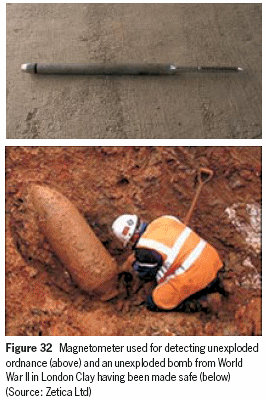Chapter 4
Part 3: Special cones: other cones
Magnetometer (for unexploded ordnance detection)
| MAGNETOMETER (for unexploded ordnance detection) 4.12 | |
 | Unexploded ordnance When developing a new or existing building site, it might be necessary to survey the site for unexploded ordnance (UXO). This depends on the site’s location and history. Many sites are contaminated with World War II air-dropped ordnance. The depth of the survey depends on the design of the foundation; is it a shallow foundation or a piled foundation? Also the composition of the subsoil is important; the penetration of irdropped bombs is much deeper in soft soils (eg peat) than in stiff London Clay. Figure 32 shows a combined magnetometer and non-magnetic CPT cone, and a UXO on a London building site. Operation The cone of a magnetometer probe for UXO detection is hydraulically pushed into the soil while the magnetometer takes real time readings of the amplitude of the Earth’s magnetic field. Buried ferrous items result in localised distortions of the magnetic field. These local disturbances are manifested as anomalies in the data that are invaluable for locating buried metal objects such as tanks, drums, pipes or bombs. |
| The caesium vapour magnetometer has a detection radius of 2.0 m for detecting large items such as a 500 kg bomb. The magnetometer probe is pushed into the soil using a standard CPT rig. A maximum pressure of 15 tonnes is normally applied as a refusal criterion. Where soils comprise made-ground deposits, hard strata or hardcover, it is necessary to drill each position and line the borehole with a plastic pipe, before pushing the probe into the soil. |

| As previously noted, when no ferrous items are detected the magnetometer takes a reading of the amplitude of the Earth’s magnetic field which gives a strait line. If unexploded ordnance (or other ferrous items) is detected, the strait line alters sharply, as shown in Figure 33. Procedures In the event of discovering unexploded ordnance, there are rigorous Health and Safety Executive protocols that have to be followed. These procedures include notifying the emergency services (eg the police) and the Ministry of Defence. |
